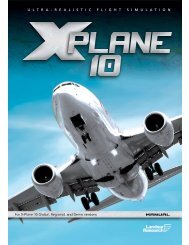Download the Plane Maker Manual - X-Plane
Download the Plane Maker Manual - X-Plane
Download the Plane Maker Manual - X-Plane
You also want an ePaper? Increase the reach of your titles
YUMPU automatically turns print PDFs into web optimized ePapers that Google loves.
4.1. CREATING THE ENGINES 61<br />
Beneath <strong>the</strong> three thrust settings is <strong>the</strong> engine’s optimum altitude, <strong>the</strong> altitude at which <strong>the</strong><br />
rocket achieves maximum thrust, in feet above mean sea level.<br />
In <strong>the</strong> upper right of <strong>the</strong> Rocket Engine Specs box is <strong>the</strong> “nozzle exit area” parameter, <strong>the</strong><br />
size of <strong>the</strong> exhaust nozzle. This is used only to calculate how large an exhaust flame to display in<br />
X-<strong>Plane</strong>.<br />
The final parameter in <strong>the</strong> Rocket Engine Specs box is <strong>the</strong> engine’s specific fuel consumption<br />
(SFC). Specific fuel consumption in rocket engines is much simpler than in combustion engines; this<br />
parameter applies at all altitudes, at all power settings. It defines <strong>the</strong> pounds of fuel burned per<br />
hour for each pound of <strong>the</strong> engine’s thrust. Note that <strong>the</strong> specific fuel consumption is <strong>the</strong> inverse<br />
of <strong>the</strong> engine’s specific impulse (Isp), <strong>the</strong> number usually discussed in relation to a rocket’s fuel<br />
consumption.<br />
Working with Twin- and Multi-Engine Aircraft<br />
Creating multiple engines in <strong>Plane</strong> <strong>Maker</strong> is quite straightforward; in <strong>the</strong> Location tab, each engine<br />
has its position defined independently (as described in <strong>the</strong> “Location” section above), as well as<br />
its propeller characteristics, if applicable, as described in <strong>the</strong> “Customizing <strong>the</strong> Propeller” section<br />
above. Engines of <strong>the</strong> same type (propeller-driving, jet, or rocket) are assumed to have <strong>the</strong> same<br />
characteristics-that is, all propeller-driving engines on an aircraft will have <strong>the</strong> same maximum<br />
allowable horsepower, <strong>the</strong> same redline RPM, and so on.<br />
The only thing significantly different about setting up multiple engines is <strong>the</strong> use of <strong>the</strong> Engine<br />
Specs dialog’s Transmission tab. This, of course, applies only to engines that turn propellers.<br />
Most aircraft designs will have one transmission per engine. Thus, a single-engine aircraft will<br />
have a single transmission, a twin-engine aircraft will have two transmissions, and so on. Exceptions<br />
are designs which use a common transmission to connect multiple engines to multiple propellers,<br />
as seen in <strong>the</strong> V-22 Osprey, as well as helicopter designs, where all rotors are geared toge<strong>the</strong>r.<br />
The number of transmissions is defined in <strong>the</strong> far left of <strong>the</strong> Transmission tab, seen in Figure 4.16.<br />
Figure 4.16: The Engine Specs dialog’s Transmission tab<br />
To <strong>the</strong> right of <strong>the</strong> “number of transmissions” parameter are <strong>the</strong> transmission settings for each<br />
engine and each propeller; engine settings are in <strong>the</strong> center of <strong>the</strong> window, and propeller settings are<br />
on <strong>the</strong> right. With multiple engines created in <strong>the</strong> Location tab, <strong>the</strong>re will be one row of settings for<br />
each engine. Note that <strong>the</strong> topmost engine here corresponds to <strong>the</strong> leftmost engine in <strong>the</strong> Location<br />
tab, and <strong>the</strong> topmost propeller here corresponds to <strong>the</strong> leftmost propeller in <strong>the</strong> Location tab.<br />
Each engine can drive one transmission, as defined in <strong>the</strong> “transmission that this engine feeds”<br />
box. Each propeller, in turn, can be driven by one transmission (set in <strong>the</strong> “transmission that feeds<br />
this prop” box). Thus, in a twin-engine plane, <strong>the</strong> port-side engine might feed transmission 1, and














